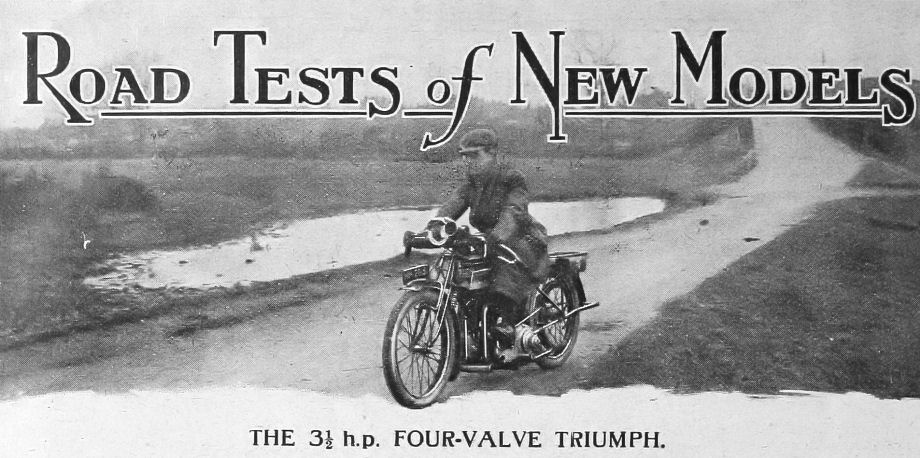


Road Tests of New Models - The Motor Cycle, December 29th, 1921.
THE 3½ h.p. FOUR-VALVE TRIUMPH.
ENGINE : 3½ h.p. (80.94 x 97mm. = 499 c.c.) with four overhead valves.
CARBURETTER: Triumph, two-lever, semi-automatic.
GEAR BOX : Triumph three-speed, multi-plate clutch and kick-starter.
TRANSMISSION: Oil-bath primary chain; protected rear chain.
TYRES: 26 in. x 3 in. Dunlop.
BRAKES : Dummy belt rim rear, horse-shoe rim front.
FORKS: Druid.
WEIGHT: Approximately 2401b.
PRICE: £120.

With the gear lever in the "I.O.M." position - right forward and permitting knee-grips - and footrests well to the rear, the sporting Triumph now really fits the speedman.

Twin inlet and exhaust valves in this case do not necessitate complicated rocker gear; four dust-proof ball bearings are used.
IN many respects the new four-valve sporting Triumph is unique. Before taking it over for a road trial, we confess that we expected to find, excepting the super-efficient engine, almost a replica of the chain-driven "four" fitted with T.T. handle-bars. The writer has had considerable eminently satisfactory experience with the latter model, and, since many of the details - gear box, transmission, control, etc. - are common to both types, the supposition was an excusable one, and the revelation was consequently all the greater. The o.h.v. 3½ h.p. machine is as different as an anti-aircraft gun is from a trench mortar.
In "feel" and in performance alike it is all that the often loosely-applied phrase "sports model" should signify; and, as those who have followed the descriptions in past issues (June 2nd and October 27th) will realise, it is as sturdily built, adequately tyred, and accessible as the hardest riding and least mechanical motor cyclist could desire.
Riding Position.
On first sitting astride the machine, the excellence of the riding position is at once apparent. The footrests are low down and well back, and just the. right amount of the rider's weight is thrown on the slightly dropped handle-bars. Knee grips are now possible, for, since our first description of this model, the rear quadrant has been moved to the fore end of the tank as on the I.O.M. Triumphs. The rear brake pedal, however, might with advantage be extended more towards the foot, although old Triumph riders will have no difficulty in finding it at any time.
The standard decompressor is fitted, but the priming tap has been dispensed with; raw petrol may be sucked into the cylinder by opening the throttle fully, shutting the air right off, and kick-starting once or twice. By this means an easy start is ensured on the coldest morning. Incidentally, the slipper type of aluminium piston fitted does not gum up so readily as cast iron one. Ignition should be fully advanced when starting on the decompressor, but should be retarded before the lever is dropped. Which brings us to another point worthy of note.
Full use should be made at all times of the ignition control. The engine, as any high-efficiency power unit should be, is very sensitive to variations of the firing point, and slight grades or slow speeds call for a corresponding amount of retard in the ignition setting. This need for sensible driving is accentuated by the high top gear ratio - 4.23 to 1, with 3 in. tyres.
Carburration and Gear Control.
Since the Triumph carburetter is to all intents and purposes semi-automatic, the air lever may be left open practically all the time, but here, again, the o.h.v. engine is slightly more sensitive than the side-valve pattern.
All plate clutches which run in oil are inclined to drag slightly until the lubricant warms up, and it has already been remarked in these columns that, in consequence, gear changing on first acquaintanceship with this particular gear box is just a little awkward. This, however, need worry no one, for very shortly one learns to operate the gears up and down with the utmost facility and absence of noise. At the same time, if the weather be at all cold, the beginner is recommended to place his toe on the brake pedal before engaging first gear.
Once under way, second gear may be engaged early, but, to enjoy the thrill of real acceleration, top should not be brought into action too soon. On the 7.02 to 1 middle ratio, one is advised to grip tightly before opening out! A momentary closure of the throttle just previous to pushing the gear lever right down, of course, ensures a much smoother change. Comfort and steering, attended to by 26 x 3 in. tyres and Druid forks, are all that could be desired from a rigid frame machine; nor do the large tyres appear to affect maximum speed to any serious degree. No speedometer was fitted to our machine, but on the one occasion that road conditions permitted full throttle - for about twenty seconds - we have no doubt whatever that we appreciably exceeded the elusive "sixty." There was no tendency to wobble.
Speed Capabilities.
However, a fairer criterion of the machine's all-out capabilities is afforded by the well-authenticated fact that one of the production models to standard specification has lapped at Brooklands at 68 m.p.h., which, in effect, means that it has exceeded 70 m.p.h.
It should also be remembered that the racing four-valve Triumph holds the 500 c.c. hour record at 76.74 m.p.h.; it is fairly obvious that a racing setting to the carburetter or a racing carburetter and the application of a little tuning, and the production model might be even further livened up - although this would certainly not be advisable in the case of nine riders out of ten.
More remarkable is the petrol consumption of the machine in its present form. Averaging from 20-25 m.p.h. - a very pleasant, slow " ponk-ponk" - the consumption is nearly 120 m.p.g., which is a notable instance of theoretical high efficiency design proving itself in practice. Four valves in a hemispherical cylinder head, ultra light reciprocating parts, and thoroughly adequate cooling, are, it will be recollected, salient features of the Ricardo design.
It is likely that twin tail pipes will be fitted to the silencer on all future models; with these the exhaust note may only be called noisy at high speeds. The valve gear, too, is surprisingly silent.
Hill-climbing and Braking.
There is little need to enlarge on the other qualities of the machine. Acceleration and hill-climbing on top gear are better than we expected, which is saying a good deal; and the brake is known to every Triumph rider. The horseshoe type front rim brake is retained for emergency use, and, as the writer has vivid memories of a lone descent of Alt-y-Bady at its greasiest with the aid of this fitment, he is not going to quibble with its retention. It is among the best of its type.
Nothing in this world is above criticism; we leave our readers to judge the seriousness of such imperfections as occurred to us. (1.) There is considerable piston slap, especially when cold; but few aluminium pistons are quite free from this. (2.) There is none too much ground clearance, especially under the foot-rest bar when cornering; in the case of a violent upset, say, in a freak trial, there seems a possibility of the left footrest puncturing the oil bath chain case. (3.) Since the float chamber is on the right of the jet, the machine cannot be propped against the left kerb without turning off the petrol. (4.) It was suggested in our correspondence columns recently that the plug was very inaccessible. Now, although two special spanners - box and cranked - are supplied, it is still none too easy to remove the plug when hot without burning one's fingers.
Little more need be said. Triumph finish and Triumph workmanship are in evidence in every detail.